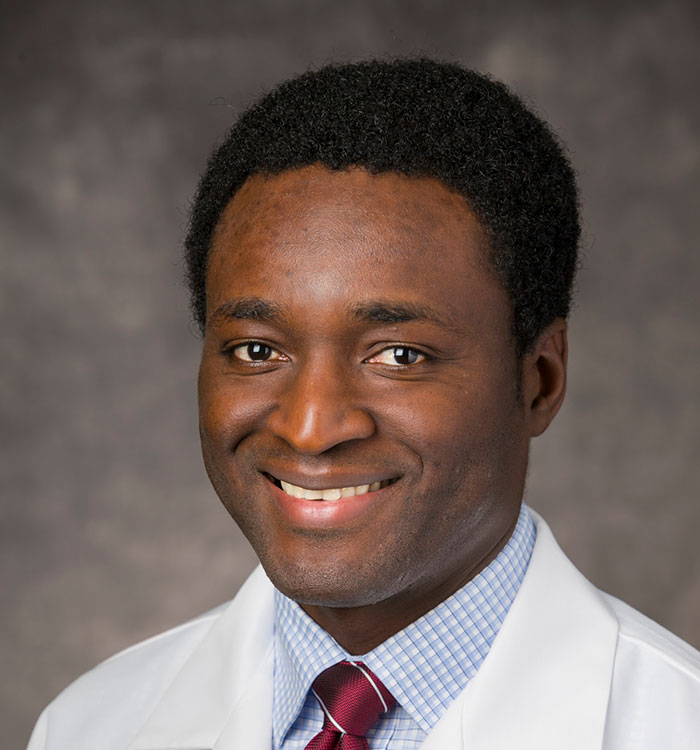Physician Spotlight: George Ochenjele, MD, UH Orthopaedic Trauma Surgeon
October 25, 2020
"Do the right thing and the rest will take care of itself."
Innovations in Orthopaedics | Fall 2020
Even in the early days of the pandemic — when guidance changed daily and scientists knew less about SARS-CoV-2 — orthopedic trauma surgeon George Ochenjele, MD, gave every patient 110 percent attention, whether they had COVID-19 or not.
 George Ochenjele, MD
George Ochenjele, MD“This is what we signed up for,” Dr. Ochenjele says. “It was a scary time for everyone, but I followed my guiding principle: Do the right thing and the rest will take care of itself.”
That guiding principle ultimately led Dr. Ochenjele to UH Cleveland Medical Center in 2016, about a year after the trauma center received its Level 1 designation. With a focus on orthopedic trauma and hip reconstruction, Dr. Ochenjele manages and treats acute fractures, pelvic and lower-extremity trauma, and post-traumatic complications such as deformities and joint arthritis. An expert in hip reconstructive surgery, he uses the direct anterior hip approach for total hip arthroplasty.
Dr. Ochenjele sees a variety of high-energy injuries, from motorcycle and bicycle crashes to auto accidents and falls. His ability to identify and solve problems has helped hundreds of patients maintain active lives.
“Someone may come in with multiple broken extremities, bed-bound and in extreme pain,” he says. “That I could repair their fractures, get them up and mobilized right away, back to their job and their family, was very appealing to me. The idea of seeing a problem, tackling that problem, and getting tangible results feels very natural to me."
STUDY HARD, FOLLOW YOUR DREAMS
In many respects, Dr. Ochenjele has overcome obstacles most of his life. Growing up in Nigeria, his parents pushed him and his siblings to study hard and dream big. They wanted their children to realize opportunities they never had.
While his parents motivated him to succeed, Dr. Ochenjele’s environment drove him to find and serve a higher purpose. In his youth, he watched family members die from illnesses that could have been treated had they had access to quality healthcare — the level of care most of us take for granted. Somehow, for his family, he had to make a difference.
His perseverance paid off. Dr. Ochenjele moved to the United States at age 18 and worked construction to pay for community college. Two years later, he earned a scholarship to attend Eastern Illinois University. He began his medical education at Northwestern University Feinberg School of Medicine. The opportunity to work with his hands — something he had done all his life — attracted him to surgery. He loved it immediately.
Dr. Ochenjele completed an orthopedic surgery residency at McGaw Medical Center of Northwestern University. An orthopedic trauma surgery fellowship followed at the R Adams Cowley Shock Trauma Center in Baltimore, the first and only integrated trauma hospital in the country and a world leader in critical care and trauma education.
OFF AND RUNNING AT UH
Exposure to a high volume of complex cases prepared Dr. Ochenjele well for his roles at UH, which include serving as Research Director for the Level 1 Trauma Center at UH Cleveland Medical Center and Assistant Professor at Case Western Reserve University School of Medicine.
He immediately tackled the challenges that came through the door, whether it was an older adult who slipped in the bathroom or an athlete who crashed her mountain bike. He also helped set up the infrastructure for UH’s growing body of orthopedic trauma research. The orthopedic trauma team has had multiple manuscripts accepted for publication and they’re presenting (whether virtually or in person) consistently at national meetings.
The latest study, published this year in the Journal of Orthopedic Trauma, co-authored with researchers from Case Western Reserve University School of Medicine, looks at the rates of deep venous thrombosis (DVT) and pulmonary embolism (PE) after a hip fracture and associated inpatient costs and length of stay.1
In another study recently submitted for publication, Dr. Ochenjele and co-authors present evidence of aspirin as an effective protocol for DVT prophylaxis in patients with acetabular fractures. “We found there was less risk of bleeding, a lower hematoma rate, and rate of DVT was the same compared to other treatment modalities,” he says. “We’re excited to share this information with our colleagues.”
Despite the disruptions of 2020, Dr. Ochenjele remains passionate about research and about treating patients in critical situations. He knows he doesn’t do it alone.
“I appreciate UH’s commitment to the trauma center’s success by providing us with dedicated staff and a dedicated operating room available 24/7,” he says. “In other institutions, trauma cases are an add-on, which means wait. When patients come here, they can get into surgery based on injury acuity.”
To refer a patient to Dr. Ochenjele, call 216-286-9483
Reference
1. Trivedi NN, Abola MV, Kim CY, Sivasundaram L, Smith EJ, Ochenjele G. The Incremental Cost of Inpatient Venous Thromboembolism After Hip Fracture Surgery. J Orthop Trauma. 2020 Apr;34(4):169-173. doi: 10.1097/BOT.0000000000001675. PMID: 31977669.


